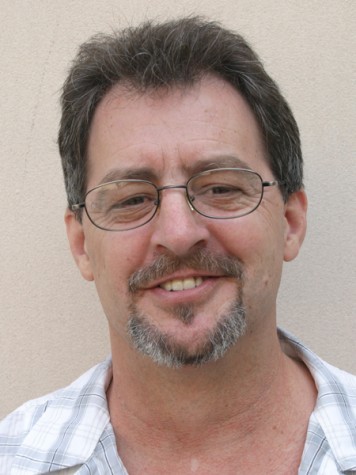Artist, electronic musician and GCC professor, Roger Dickes is a modern day Renaissance man with a passion for art, who also voices concern for today’s economic crisis.
Dickes, 40, was born in New York City but raised in New Jersey; he currently resides in the La Brea district of Los Angeles.
Although Dickes has taught computer animation for nine years, he says he is an artist first, “I still create and show my work and that’s what I consider to be an artist.”
One of the reasons that he came to the college, besides the fact that he enjoys teaching, was to support his art as well.
“I could probably sell my pieces, but I feel like it takes the meaning out of piece when you use it to make a profit,” said Dickes, explaining how terrible he would feel if he used his passion to make money, because that is not what art is for.
Dickes is also director of the art gallery, which is located in the lobby of the library. While running the gallery does require a lot of extra work, including maintaining the gallery’s Web site, Dickes enjoys every minute of it, and finds what he does very rewarding
“In the gallery, we like to show art that is conceptual, meaning that the artist is more concerned about the meaning of the work and also what problems are being depicted within that piece,” said Dickes.
Dickes described how to examine contemporary or modern art.
“Although it can look very simple,” said Dickes, “most of the time you have to look very closely to see all the detail that really goes into it.. I get the same enjoyment out of looking at a contemporary piece as I do looking at a classical piece of art.”
After attending Art Center College of Design in Pasadena, Dickes was hired as technical director for “South Park: Bigger Longer & Uncut” in 1999.
“When you make an animated movie like ‘Wall-E,’ you come in with an approved set storyboard, but with ‘South Park,’ they were constantly changing the storyboard on the fly.”
Dickes has also worked with fellow artist Liz Larner to create a 3-D image presentation for Riverside Pedestrian Bridge, which was later built by Disney Imagineers, and now connects the main lot to the animation studio.
“Obviously it was good presentation because the bridge really was built.”
The bridge is located at the Walt Disney Studios in Burbank.
Occasionally, Dickes does freelance work for commercials, such as creating a computer- generated image of a Baby Ruth candy bar.
Suddenly, Dickes received a message on his phone. He immediately turned around and used the computer to access the Los Angles Times Web site.
“One of my friends just e-mailed me and said that the Dow [Jones] went down 20 points,” said Dickes. “Oh my God, why would [he] do something like that to me?”
Ken Roskos, a former student who has taken multiple workshops under Dickes’s supervision said, “Roger has some very interesting approaches to teaching, but it always turns out to be a great time. I always learn a great deal.”
Dickes said that in today’s world of animation he does not see the old pen and paper style ever coming back.
“It’s all going digital and it seems like it’s going to stay that way, but in the fine arts there will always be that traditional style of paintbrush and canvas.”
Even with such a busy schedule, Dickes also has time to compose and record his own electronic music.
“I feel fortunate to be doing the work that I’m doing both teaching and creating art, but mostly to be here at GCC where I have the support of so many different people.”

